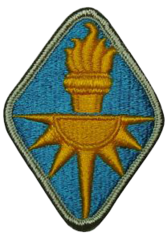US Army Intelligence Center of Excellence, US Army Training & Doctrine Command
US Army Intelligence Center of Excellence
Update canvas image
Image uploaded by:
Group editing is not supported in IE8.
Sorry, group editing is not supported in your browser. Editing is supported in Internet Explorer 9 or later, Chrome, Safari, and Firefox.
Select Image Crop

Upload logo
US Army Intelligence Center of Excellence, US Army Training & Doctrine Command
- Actions
- Show unit hierarchy
Share this page
Subordinate units:

US Army Intelligence Center of Excellence, US Army Training & Doctrine Command
Upgrade your browser in order to edit this page.
 Edit
Edit
About
The post sits at the base of the Huachuca Mountains. That name comes from an obscure, local Indian language which, when loosely translated, describes a "place of thunder."
Thunder Mountain is the nickname of choice among locals and it’s accurate as well, depending on the time of the year. The sight of dark clouds, cascading down the mountainside while electricity, thunderclaps, and water fill the air can be as awesome to modern man as it must have been to ancient Indians. The name must have referred to the visual spectacle rather than its frequency because, actually, Thunder Mountaineers enjoy some the of the mildest and best weather in Arizona.
The original Fort Huachuca cantonment was declared a National Historic Landmark in March 1977 during a four-day centennial celebration. A rustic wooden sign and reconstructed artillery piece sit on the northeast corner of Brown Parade Field, the center of post life during the days of horse soldiers. Surrounding buildings and homes are maintained with the appearance and flavor of the old days.
 Edit
Edit
Unit history
Frt Huachuca is a product of the Indian Wars of the 1870s and 1880s. In February 1877, Colonel August B. Kautz, commander of the Department of Arizona, ordered that a camp be established in the Huachuca Mountains. This camp would offer protection to settlers and travel routes in southeastern Arizona while simultaneously blocking the traditional Apache escape routes through the San Pedro and Santa Cruz valleys to sanctuary in Mexico. A temporary camp was established at the post’s current location on March 3, 1877, by Captain Samuel Marmaduke Whitside with two companies of the 6th Cavalry. The site was selected because it had fresh running water, an abundance of trees, excellent observation in three directions, and protective high ground for security against Apache tactical methods. Camp Huachuca was redesignated a fort in 1882.
In 1886, General Nelson A. Miles designated Fort Huachuca as his advance headquarters and forward supply base for the Geronimo campaign. Geronimo’s surrender in August 1886 practically ended the Apache danger in southern Arizona. The Army closed more than 50 camps and forts in the territory, but Fort Huachuca was retained because of continuing border troubles involving renegade Indians, Mexican bandits, and American outlaws and freebooters.
In 1913, the 10th Cavalry "Buffalo Soldiers arrived and remained almost 20 years. The 10th Cavalry joined General John J. Pershing in the 1916 expedition into Mexico and, during World War I, it was assigned the mission of guarding the United-States-Mexico border.
By 1933, the 25th Infantry Regiment had replaced the 10th Cavalry as the main combat unit for the fort. The 25th, in turn, was absorbed by the 93rd Infantry Division during World War II. When the 93rd departed for the Pacific in 1943, the 92nd Infantry Division arrived at the fort for training and subsequent
assignment to the European Theater. During the war years, the troop strength reached 30,000 men at the fort, which in the 1930s had been described as suitable for a brigade-sized unit of about 10,000 men.
At war’s end, the fort was declared surplus and transferred to the State of Arizona. It was reactivated during the Korean War by the Army Engineers.
A new era began in 1954 when control passed to the Chief Signal Officer, who found the area and climate ideal for testing electronic and communications equipment. The importance of the fort in the national defense picture grew steadily from that moment. In 1967, Fort Huachuca became the headquarters of the U.S. Army Strategic Communications Command.
Then, in 1971, the post became the home of the U.S. Army Intelligence Center and School, bringing with it the School Brigade.
The Strategic Communications Command became the U.S. Army Communications Command in 1973, subsequently changing to the U.S. Army Information Systems Command in 1984.
In October 1990, the post changed hands with the U.S. Army Training and Doctrine Command became the new host command; the U.S. Army Intelligence Center and Fort Huachuca now operates the post.
Today, Fort Huachuca is a major military installation in Arizona, and one of prominence throughout the Southwest.
Most recent contributors: MAJ William Frobe




